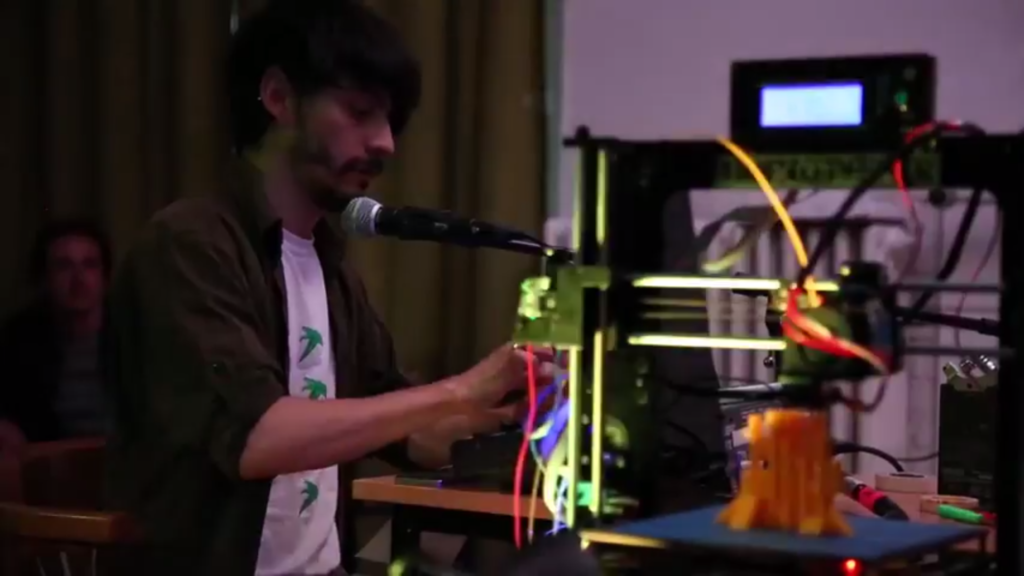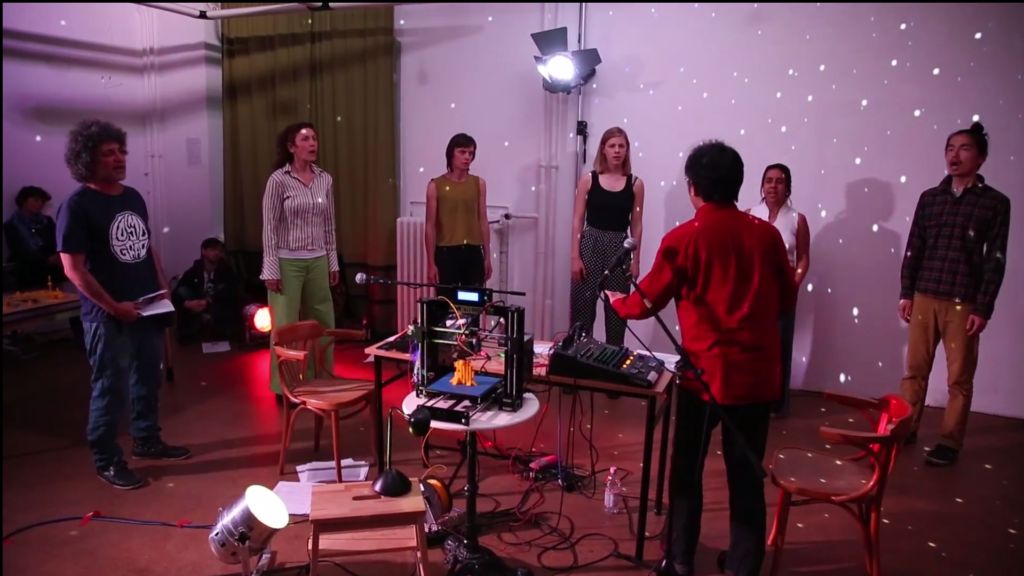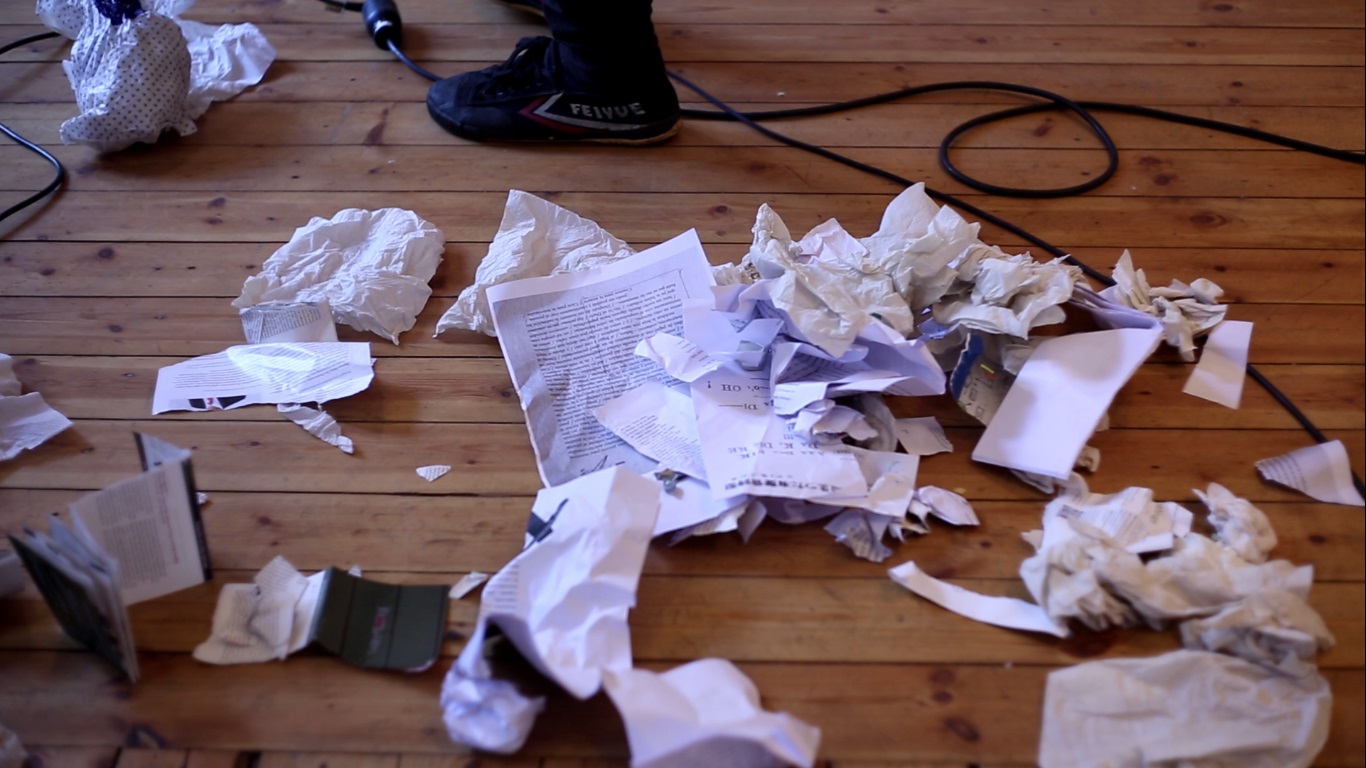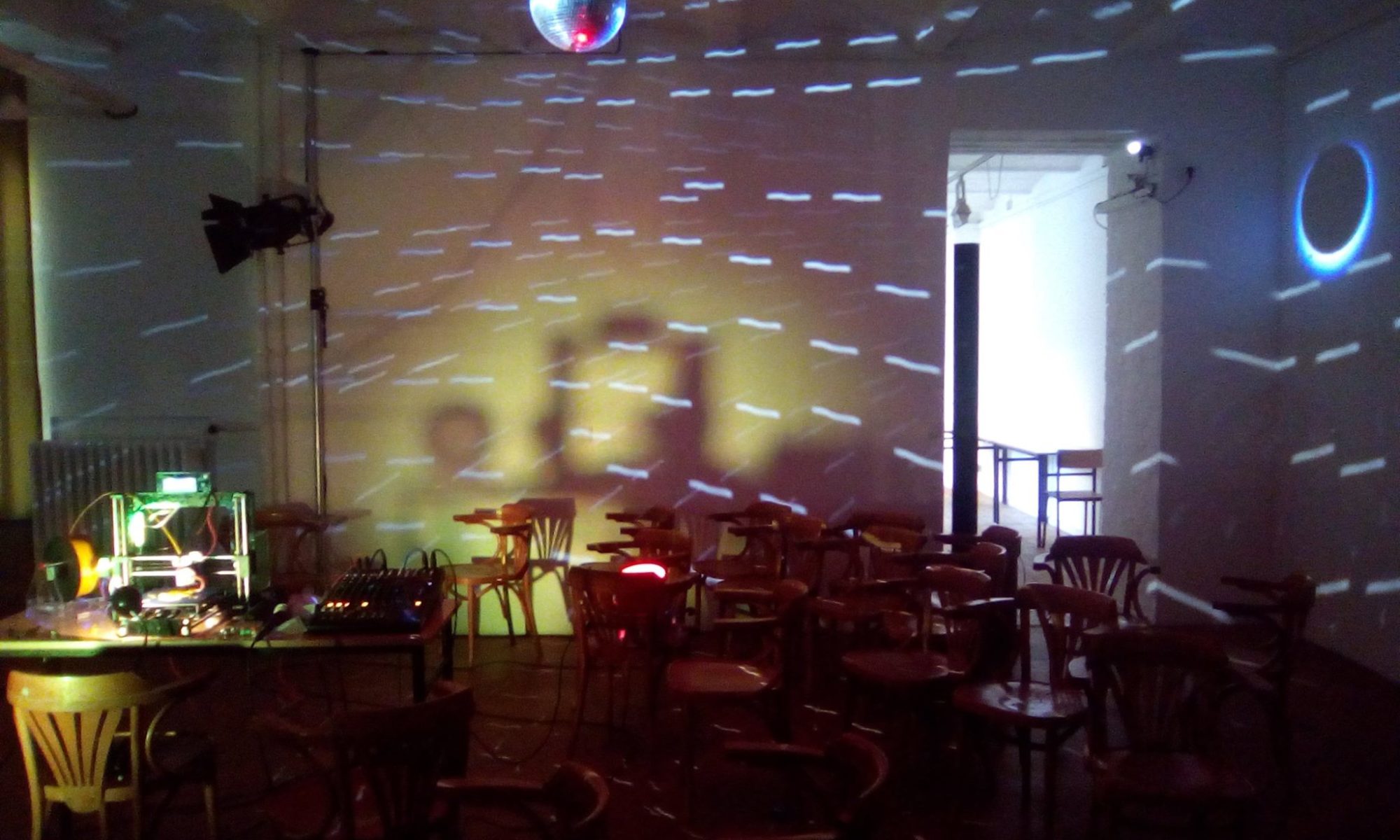Interviewer: Florian Neuner. Translated from German by Thomas Nießer.
As I came into the Lettrétage on Whitsunday, a 3D printer is already working. The sound of the machine is being recorded with a microphone and amplified. It cheeps and hisses like the sound of a command centre in a 1960s spaceship. By the end of the conversation, the product will be finished printing: A yellow something of a few centimeters in height, which at first sight you could take for a futuristic, biomorphic architectural model. At second sight the structure of a concealed X is recognizable.
Florian Neuner: Did you meet each other for the first time here at the Lettrétage speed-dating or did you already know each other?
Tomomi Adachi: Daniel didn’t take part in the speed-dating. We first spoke with each other through Skype. (Editor’s note: Like all foreign artists, Daniel Malpica took part in speed-dating through Skype)
FN: What was the starting point of you working together? What common interests did you discover?
As an answer, Tomomi Adachi puts great big plastic X on the table.
Daniel Malpica: That is my obsession with the X!
TA: At the beginning we only had the X as a starting point. Daniel explained that he works a lot with this letter. That quickly leads to the question of how one should pronounce this letter. I am very interested in the Japanese Dadaism of the 20s, and there is a piece of sound poetry by Hide Kinoshita that is very important to me: Voice Sound Poetry Form Begun with –X-. Therefore, I also have a special relationship with X. Consequently, we wanted to do something to around X.
DM: I’ve been working for some years on a book which carries the title, Mit X geschrieben (written with X). I’ve developed a special interest in this letter. In Spanish there is the word cima, which means summit. Sima with an s however, means sinkhole. In the book I show that the letter X is the point at which cima and sima coincide. When one plays with the sounds of c and s, an X is also produced.
I write in Spanish, my background being Mexican. X is also interesting in the context of colonial history. When the latin alphabet was imported into Mexico, many indigenous languages adopted the X. I use the letter to deal with quite different things. I also develop graphic scores for musical interpretation. I immediately had the impression that I should work with Tomomi!
FN: How would you describe your literary fields of work? Tomomi, I know that you – amongst other things – write and interpret auditory literature.
DM: I am an author but also a graphic designer. Therefore, literature and graphics merge for me. One could speak of visual poetry. I live in Finland and organise many multi-media literature-events there. We bring a lot of languages, musicians and authors together. It has quite an experimental dimension.
FN: What kind of play, performance or exhibition are you working on here at the moment?
TA: Our exchange of ideas began a few months ago. My first thought was to do something with 3D-printing. Up until now I haven’t had much experience with it, but I wanted to deal with it and create something like three-dimensional literature. To do that, one needs three-dimensional letters. I thought that it somehow fits with X, as X can mean anything. So I wrote an email to Daniel. He agreed. It turns out that he also deals with various dimensions in his writings.
DM: This origami thing…
TA: I was interested in that.
DM: There is a poem by me which contains the instructions to folding a piece of Origami. Behind it was the idea of three-dimensional literature.
TA: We had a budget at our disposal. And I thought we should acquire a 3D-printer with it. The 2-dimensional printer was invented in the 15th Century. Now we can finally print in 3 dimensions! We’re developing new characters. It’s a kind of Pentecostal story!
Besides that we started an appeal and looked for a performer. In my projects I like working with so-called normal people with completely different backgrounds. For this project, I found it important that we include as many different languages as possible as it is about X. We are developing these new characters so that people from different cultures can use them together. So we looked for seven people who spoke different languages. We are currently working out a performance for Tuesday which will include voice and movement – also the movement of the printer, which will be an important part of the performance. He or she – I don’t know – is in the process of writing. It is a writing movement.
FN: What languages do your performers bring to the performance?
TA,DM: Japanese, Mexican Spanish, French, German, Dutch and Portuguese.
DM: I use translations of my poems in many different languages. I had the opportunity to have some of my poems translated into Swedish, English, Finnish and German. So, we can use this version. Among our performers is even an opera singer. I am very excited!
FN: The printing process could also be described as a translation process. A construction plan gets translated into a three-dimensional object.
DM: The printer looks very complicated but in reality it is fairly primitive!
TA: I think that what emerges is a text, a new kind of text.
DM: The most obvious things are first of all the objects, which look like architectural models. But then we put text into the design. We become aware that the printer has its own language. That’s what we look to explore. First, of course, we had to familiarize ourselves with the software. But we are also interested in the noises of the machine.
FN: This technology is new for both of you?
TA: Completely new.
DM: As a graphic designer I have worked very basically with printing processes.
TA: We received an assembly kit, and I put it together during the two weeks prior to Daniel’s arrival. That was quite tough! There is a construction manual but no operating manual. Daniel got to grips with the software very quickly though.
DM: I am quite familiar with design platforms. I find that allows you to operate it fairly intuitively. That helped us save time.
DM: The products aren’t really that big…
FN: Who buys such things?
TA: Me!
FN: What are they normally used for?
TA: I think they’re used in product development, in order to make prototypes. And obviously in architecture. Weapons can also be made with 3D-printers.
DM: They are currently very popular. I don’t really see any practical use for them. Maybe the hype will also go away soon.
FN: What kind of objects do you want to produce with the printer?
TA laughs

DM picks up an object: In this example, the X is both positive and negative. This is a play with geometrical forms, with letters, and with the X. But it is also about allowing things to merge into one another. What happens when we bring text into these three-dimensional structures?
TA: During the performance we want to print a character, an object. We still have to work out how we will do this.
FN: How long does it take to print such a thing?
TA: One-and-a-half to two hours.
FN: Would you describe it as visual poetry?
DM & TA in unison: Yes, of course!
DM: At the end, there is an object as the result. Even if the machine should crash, some kind of three-dimensional object would be left over. It is an interesting thought that literature can have this third dimension.
TA: We don’t attach any meaning to it, but in the end, words will emerge, text.
FN: Do you want to organise an exhibition with these objects?
TA: We’re not sure. In any case, a performance will take place.
FN: The CON_TEXT series is about developing and trying out new forms of how to present and communicate literature. What is your approach? What experiences with different formats of literature events have you had?
DM: I am quite familiar with unconventional ways of conveying literature, but perhaps from a somewhat different perspective. As an author I have often had the opportunity to cooperate with artists and musicians and thus to overcome the barriers between the disciplines to a degree. I always would designate this as literature, however. The other perspective is that of the literary activist: As producer and facilitator, I am in Finland confronted with authors with very different backgrounds, who write in different languages. How can one present their work, translate their texts? The project, in the context of which I am dealing with these questions, is called Sivuvalo. We organise publications and events. We bring multi-lingual authors together with artists, designers and musicians. We have texts translated and we project them at events. That is my approach to unconventional forms of communicating literature.
TA: If one wants to renew forms of conveying then this has to go along with a renewal of the contents. The starting point is initially the two-dimensional literature, isn’t it, the conventional production of meaning. But now we have a new technology, and therefore literature has to be renovated. That is the greatest upheaval since Gutenberg! (laughs)
DM: The result, the project as a manifestation of literature is more interesting to us than the presentation. That will definitely take place. There will be an audience in attendance, and the people will get a real impression of the project.
FN: What does it mean, to place this project in the context of literature? How would it differ if it took place in say, an art room or in the context of a music festival?
TA: For me, this project really belongs in a literature context because after all it is about characters for writing. Poetry can be anything. One just has to look at what possibilities the Avant-garde movement of the 20th Century has already explored.
DM: The first poem was the drawing of a hand in a cave, that is visual poetry. To regard something like that as literature, opens up the opportunity to conceive language and communication in ever more abstract ways, not so closely tied to a concrete meaning. For me, this performance definitely belongs within the context of literature.
FN: Creating new characters, does that also mean working on a new language?
TA: It’s the first step! (laughs)
FN: Historically it’s played out in reverse: There existed a spoken language, which was then committed to paper.
FN: What role do interdisciplinary/intermedial aspects play in your work? If I understand this correctly, from the side of literature, authors were chosen for the CON_TEXT project, who had already shown that their understanding of literature goes beyond writing and the printing of text on paper.
TA: I think I don’t mix these things. I can take music as starting point and wherever I then end up, it will remain music. In this case it is about literature, whereby literature at the same time also includes sound and visual qualities. I don’t mix up anything, that is rather a digging for the essence.

DM: I see it similarly. I would not say that I bring literature and design together. Such considerations do not play a role in the conception of works. I don’t want to limit myself in this. At first glance design and literature appear to be almost contradictory and to go together badly. Design aims for clarity, whereas in literature it is more about relinquishing.
FN: You can report back about experiences with the literary life in several countries, in Japan, Finland, Mexico. What observations have you made there? The German-speaking world is still dominated by the tradition of the so-called lesung (reading). An author steps on stage, reads from his book, and after that there is a discussion or sometimes not.
TA: Literature in Japan is a conservative metier. It is mostly about the publication of books. And the reception plays out that people read the books silently to themselves. There are also readings, they’re so boring!
DM: Mexico is complex. There is a very conservative scene, but then there are quite different approaches as well. That makes it really difficult to categorise and so it depends on whether an event is considered to be a literary event. Finland is a small, a slightly conservative country. I find that the presence of international authors in the Finnish literary life leads to new dimensions and encourages experimentation. A lot is happening, even if it isn’t all great. What I find really good about South America is the opportunity for authors from completely different, often contradictory aesthetic attitudes, to come together in one place and mutually respect each other as writers. In Finland however, there is a tighter definition of who an author is. Often, it is simply about who has released the most books.
FN: Let us return to the opening question: What does three-dimensional literature mean? In the concrete poetry, for example, there are positions as the one of Josef Bauer, who displays letters as three-dimensional objects, which take on a sculptural quality. You could think of something like that.
DM: I think, for example, of the tradition of artist books, of authors who quite deliberately worked on all dimensions of the book creation. They regarded the book as vessel and the vessel as three-dimensional object. This is, I think, something different from treating writing characters as sculptures.
TA: Two-dimensional literature is literature for the eyes. There are however, other three-dimensional traditions, If I may think of braille, the system of writing for the blind.

